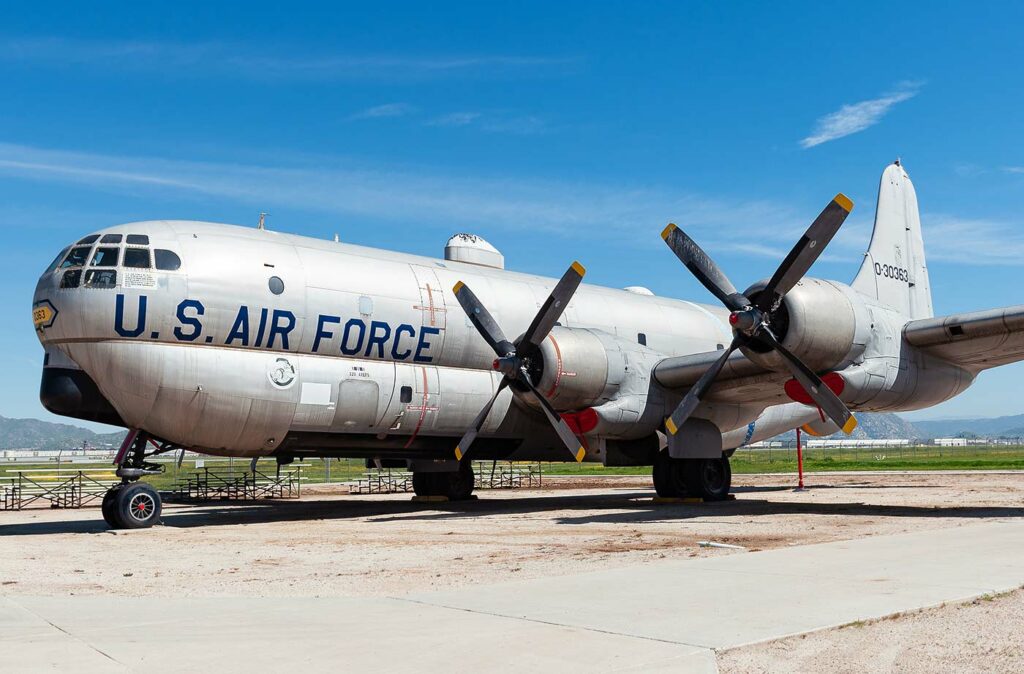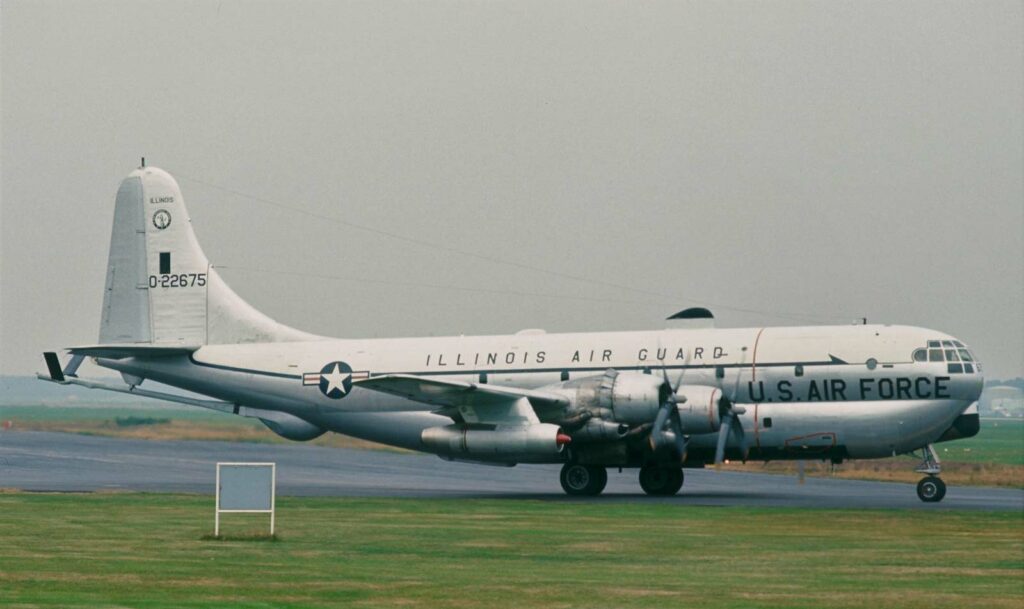The Boeing KC-97 Stratofreighter was a long-range heavy military cargo aircraft adapted for aerial refueling.
In brief
The Boeing KC-97 Stratofreighter was a pivotal aerial refueling and transport aircraft used primarily by the United States Air Force. Based on the Boeing C-97 Stratofreighter and the B-29 Superfortress, it was a key component in extending the range of U.S. bombers and fighters during the early Cold War. The KC-97 featured a distinctive double-deck configuration and was capable of carrying large cargo or troops along with its refueling role. It served as the backbone of the Strategic Air Command’s refueling fleet until the introduction of jet-powered tankers, embodying an essential transition period in aerial refueling technology.
The Boeing KC-97 Stratofreighter was an American aerial refueling tanker derived from the Boeing C-97 Stratofreighter, which was itself a military derivative of the B-29 Superfortress bomber. Its development marked an important evolution in air mobility and refueling capabilities, significantly extending the operational range of aircraft.

History of the Development of the Boeing KC-97 Stratofreighter
In the post-World War II era, as tensions rose and the Cold War began, the need for a capable long-range bomber fleet became evident. To extend the reach of its bombers and fighters, the United States Air Force required an effective aerial refueling aircraft. The Boeing KC-97 Stratofreighter was developed to meet this need, building on the success of its predecessor, the C-97 Stratofreighter, which in turn was based on the B-29 Superfortress bomber’s design.
The program for the KC-97 was launched by the U.S. Air Force in the late 1940s, with the first flight occurring on November 9, 1950. The development of the KC-97 was driven by the strategic necessity to extend the range of the U.S. bomber fleet, critical in maintaining a credible deterrent and rapid response capability during the early Cold War years. The KC-97 played a crucial role in the Strategic Air Command’s operations, allowing bombers and fighters to reach distant targets without the need for bases nearby.
The KC-97 did not have a specific NATO nickname, as it was primarily an asset of the United States and operated largely within the framework of the U.S. military strategy.
Design of the Boeing KC-97 Stratofreighter
The Boeing KC-97 Stratofreighter was distinctive for its combined cargo and aerial refueling capabilities. The aircraft was designed with a double-deck structure, the upper deck for the flight deck and the lower for cargo, troops, or fuel tanks. It was equipped with four Pratt & Whitney R-4360 radial engines, the most powerful piston engines of their time, each producing about 3,500 horsepower.
The KC-97 had a length of approximately 110 ft (33.5 m) and a wingspan of 141 ft (43 m). It was capable of carrying a significant payload, with a maximum takeoff weight of around 175,000 lbs (79,378 kg). The double-deck design allowed for efficient use of space, accommodating both fuel and cargo. However, the aircraft’s large size and piston-engine technology made it less efficient at higher altitudes and slower compared to the emerging jet aircraft, leading to operational limitations as jet technology advanced.
Performance of the Boeing KC-97 Stratofreighter
The performance of the KC-97 was a balance of heavy lifting capability and range. It could reach a maximum speed of approximately 400 mph (644 km/h) and had a range of around 2,300 miles (3,700 km) when fully loaded. Its service ceiling was about 30,000 ft (9,144 m). These capabilities allowed it to effectively refuel bombers and fighters, extending their operational range significantly.
Compared to other refueling aircraft of the time, the KC-97 was one of the most capable in terms of load capacity and range. However, as jet technology became predominant, the KC-97’s piston engines and performance at altitude became less compatible with the faster, higher-flying jet bombers and fighters, leading to the development of jet-powered tankers like the KC-135 Stratotanker.
Variants of the Boeing KC-97 Stratofreighter
The Boeing KC-97 saw several variants over its service life, each designed for specific roles or with improvements. The primary variants included the KC-97G, the most numerous version, which served as both a tanker and a cargo aircraft. The KC-97L was an upgraded version with additional jet engines to increase performance, especially takeoff and climb capabilities. Other variants like the C-97 and KC-97F were built for specific purposes like medical evacuation or as pure cargo transports.

Military Use and Combat of the Boeing KC-97 Stratofreighter
The Boeing KC-97 Stratofreighter primarily served in a support role rather than direct combat. Its main mission was aerial refueling, significantly extending the range and endurance of the U.S. bomber and fighter fleet. This capability was crucial during the Cold War, allowing for global reach and the ability to maintain airborne alerts as part of the nuclear deterrent strategy.
The KC-97 played a vital role in various military operations and exercises, demonstrating the strategic mobility and flexibility of the U.S. Air Force. It refueled aircraft all over the world, from the Arctic to the tropics, in exercises and real-world deployments. As jet technology advanced, the KC-97 began to be phased out in favor of the faster, more capable KC-135 Stratotanker. The aircraft was retired from active duty, with some converted for other uses or sold to allied countries for continued service in various capacities.
The Boeing KC-97 Stratofreighter was an essential aircraft in the evolution of aerial refueling and strategic air mobility. As one of the first dedicated refueling aircraft, it extended the reach of U.S. air power and contributed significantly to the U.S. strategy of global presence and nuclear deterrence during the Cold War. Its development and service bridged the era of propeller-driven bombers to the age of jet-powered aircraft, marking an important period in military aviation history. While eventually surpassed by more advanced technology, the KC-97’s legacy endures in the critical role aerial refueling plays in modern military operations.
Back to Transport planes.